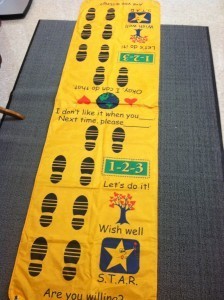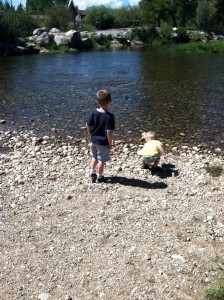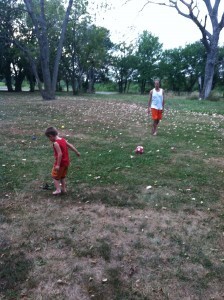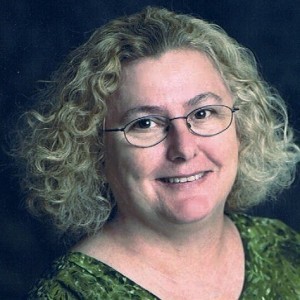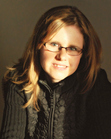Kate Meadows's Blog, page 7
November 7, 2014
Stories from the Dead: What I Never Knew about His Past
For the past several weeks, I have been reading a collection of newspaper columns that my grandpa, Charles “Bucky” Neely, wrote in the late ‘90s for a now-defunct hometown newspaper. The stories, recollections of his life published in The Sublette County Journal in Sublette County, Wyo., are bound neatly into a collection he titled, “Stories with Bucky.” He gave copies to each of his kids and his grandkids when he produced the book. Back then I was a teenager, and not much interested in reading stories about the so-called “old-timers.”
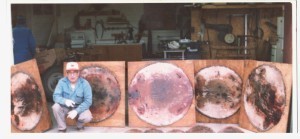
Grandpa with his prized beaver hides, stretched neatly onto various sized boards.
How the world changes when you grow up a little.
My grandpa is gone now, and I treasure this book of his as if it’s a beloved teddy bear. Tears spring to my eyes in the quiet moments I spend reading his words at the kitchen table. In this book I am discovering so many things about my grandpa I never knew. For example:
I read that he was accepted into the Navy, but never reported for duty.
I never knew his family raised sheep for a time.
I read about how, at age 17, he took a bus from Rock Springs, Wyo., to San Diego by himself – a boy who had never been to a city and did not even know how to read stop lights – to track down his parents (he had been living with his uncle in Wyoming) and ask their permission to enlist in the service before he turned 18.
Here’s the story, in his words:
My folks had sold their sheep by now and had moved to San Diego, California and I decided to travel down there and see if I could get permission from them to join the service.
It was quite a trip for a country boy who had never been in The Big City. I rode the train from Rock Springs and that was quite an experience.
When I finally arrived in San Diego I was scared half to death. I had my folks’ address in my pocket and they lived in Ocean Beach on Del Monte Avenue. From the Union Depot, Broadway Street looked a quarter of a mile wide to me and people and vehicles all over and I could see a building across the street that had a big sign saying ‘Travel Information.’
I sat on a bench there for quite some time figuring out how to get across the street and didn’t savvy the red and green lights and didn’t know how to use the pay phone to call my folks to come and get me.
It looked darned dangerous to me to try to cross the street so I talked to a Yellow Cab driver and had him haul me around the block and finally got to the Travel Information place. He assumed I was nuts. The ride cost a dollar.
At the Travel Information they told me it was simple – just catch the Ocean Beach bus that would be along in a few minutes.
I got on the bus and went to a rear seat. I wasn’t sharp enough to know when to get off and rode the complete route two times. On the third trip the driver noticed I was still there and had me sit in the front seat right behind him and said, ‘I will tell you when to get off.’
He dropped me off on Del Monte Avenue. He didn’t tell me which way to walk to find the right address so I walked a few blocks the wrong way and came to the Pacific Ocean. I stood there with my mouth open for a while and decided I would have to walk back the other way. After about four blocks back the other way I came to house #4821.
I walked in the door and spoke to Mom and was really tickled to death to get there.
Mom said, ‘Son, did you have any trouble finding us?’
I said, ‘No Mom, not a bit.’”
My heart pounds as I read his recollection. It pounds out of sheer amazement at this boy, who to me had all the gall and innocence in the world. It pounds out of disbelief: How could I have never known these details of his life?

Bucky’s Repair (now Bucky’s Outdoors), circa 1960.
Because I never asked. Because, until now, I have not taken the time to invest in his memories.
Yet, I’m glad I waited to steep in his words. I think that, had I read these stories when I was 16, they would not have mattered – at least not nearly to the degree they do now.
Now, living a thousand miles away from my own parents, I call my dad in the middle of the work week, interrupting him at Bucky’s Outdoors, the small engine repair and retail shop that still bears my grandpa’s name.
“Did Grandpa ever tell you the story of the hot rooster?” I ask.
The story goes that Grandpa’s mom had the pressure cooker going on a cold, rainy day, “doing up an old red legged rooster that was declared surplus.” Grandpa’s brother was in the corner, cleaning an old 30.06 rifle that had gotten wet.
Jeff Bills had his back turned to the old Monarch cook stove sharpening his pocket knife when all of a sudden a loud “Pow!” as the lid blew off the pressure cooker, a drumstick glanced off the ridge log and hit Jeff in the back. He let out a loud squall, and yelled, “Oh, God! I’m shot in the back!” He assumed the old 30.06 had went off and it scared us all to death until we figured out it was just the piece of hot rooster.”
My dad laughs like a little kid. “Yes,” he says. “I remember that one.”
October 21, 2014
Winning Ingredients: An Evening (or Two) of Chicken Soup for the Soul
 Last March, I opened Chicken Soup for the Soul’s “Communique,” a newsletter exclusively for writers who have published stories in Chicken Soup for the Soul. The announcement didn’t surprise me – Chicken Soup was launching its own food line. (I had figured it was only a matter of time. How could a brand founded on sharing stories to warm the heart, a brand whose namesake is the very comfort food we all know, not at some point dive into the food market?) But then my heart skipped in excitement. The announcement was asking for CSS contributors to host dinner parties based around the new food line. Ingredients and recipes would be provided for all writer hosts.
Last March, I opened Chicken Soup for the Soul’s “Communique,” a newsletter exclusively for writers who have published stories in Chicken Soup for the Soul. The announcement didn’t surprise me – Chicken Soup was launching its own food line. (I had figured it was only a matter of time. How could a brand founded on sharing stories to warm the heart, a brand whose namesake is the very comfort food we all know, not at some point dive into the food market?) But then my heart skipped in excitement. The announcement was asking for CSS contributors to host dinner parties based around the new food line. Ingredients and recipes would be provided for all writer hosts.
Dinner party? Sharing stories? Invite your friends? Ingredients and recipes provided?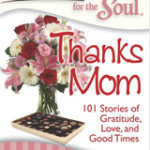
Um, hello. I fired off an email, asking to be considered as a host.
What might an evening with Chicken Soup for the Soul look like at your place? The coordinators wanted to know.
I singled myself out as a true Midwesterner who loves good company and who loves cooking good food AND eating it.
“I would fashion a special night around good food and good writing, inviting friends to come for a free meal, relax with a glass of wine, and hear a heartwarming essay from a Chicken Soup for the Soul book,” I wrote.
My essays appear in CSS: Thanks Mom (2010), The Dating Game (2013) and The Multitasking Moms Survival Guide (2014). The capstone to the evening would be a private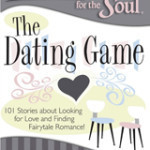 reading, to go along with dessert. I bookmarked my essay, “Due Dates,” from The Multitasking Moms Survival Guide, blocked off a Saturday night, and sent invitations.
reading, to go along with dessert. I bookmarked my essay, “Due Dates,” from The Multitasking Moms Survival Guide, blocked off a Saturday night, and sent invitations.
Seven dear friends of mine said “yes” to the invite. Lynn showed up with a box of gourmet chocolate covered almonds. Ann showed up with a bottle of white, Karen with a bottle of red. Pasta was simmering on the stove – the beginnings of Sausage, Broccoli Rabe and Cannellini Beans with Tomato Basil Sauce (key ingredient: CSS Tomato Basil pasta sauce). As I cubed avocado for my own avocado orange salad, I surveyed the circle of women in my kitchen.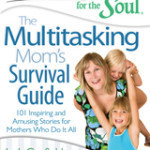
Some knew each other, but many had shown up with only one thing in common: They knew me.
We ranged in age from late 20s to mid-60s. I welcomed friends from almost all avenues of my life: friends from church, friends from the local Moms Club, friends from writing circles, and friends whom I’d met (and grown to love) through mutual acquaintances. Some of these women I have known for several years; others I have known for several months.
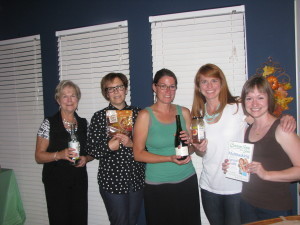
Sweet friends who lingered after the reading and dessert.
These diverse threads of connection did not hinder conversation; they enriched it. Ask any one of them about the story of the pet gerbil that got loose in a classroom, and how and why my friend – who was a teacher at the time – killed it and later had to answer to her student who owned the thing, and you’ll be met with a hearty laugh. This was the lighthearted conversation that so many of us crave day-to-day. Over bowls of Minnestrone Soup and Vegetable Bean Chili, we lost ourselves in the kind of talk that carries with it no sense of expectation, no heaviness. An all around congenial, feel-good time.
And I needed that lighthearted atmosphere around the dinner table. Because when I sat down on the living room steps to read “Due Dates,” I almost cried. Not out of sadness, but out of the sheer overwhelm of emotion: over the joy of my two little boys, over the fierce passion God has given me for writing and sharing stories that are both mine and others’, over the web of support that, at that moment, literally surrounded me.
Well, the emotion may have just been the wine talking.
But I don’t think it was. What could be better, I thought, than an evening like this? In the comfort of my own home, 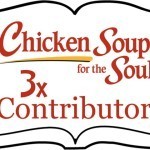 engrossed in not one, but two things I love to do (cooking and sharing stories), and being able to share it all with others who mean so much to me.
engrossed in not one, but two things I love to do (cooking and sharing stories), and being able to share it all with others who mean so much to me.
The winning ingredients for a night with Chicken Soup for the Soul? Good food. Good people. And good stories that resonate well past the evening meal.
*Join me for ANOTHER EVENING of Chicken Soup for the Soul in November! In honor of National Novel Writing Month (NaNoWriMo), I will host a special Chicken Soup for the Soul writer’s workshop at the Louisburg Library. Mon., Nov. 17 at 7 p.m. I will also sign copies of Chicken Soup for the Soul books in which my essays appear. (A fabulous gift idea – hint, hint!) Register here.
October 7, 2014
Writer Interview: Christina Adams on Autism, Camel’s Milk, and Inspirational Spaces
I met writer Christina Adams while living in Orange County, Calif. I had started a creative nonfiction writers group, and she was one of several who faithfully attended. In our meetings, I came to know Christina as a beautiful person: a writer who is whip-crack smart and not afraid to confront reality. Read on for what drives Christina to write, despite (and because of) tremendous hardship and call after call to rise in the face of adversity.
1) Where (in what state) do you write?
I write in southern California, where I live in Laguna Beach.
2) Do you find that place – your geographic surroundings – influence your writing?
Yes. I started using Appalachian settings in a novel that won a graduate school prize. I was polishing it when my son was diagnosed with autism. I dropped the novel to create his therapy program (as told in my book, A Real Boy). My new life inspired a transition to nonfiction, and I started writing memoir and essays for magazines, newspapers and NPR. My nonfiction reflects my lifestyle in California, but I sometimes travel to interview my subjects, both in the US and internationally. I try to understand and convey their origins and values. Some of my most inspiring interviews have been with the Amish, Middle Eastern and Somali people I’ve met.
3) Describe your writing space. How did it come into being, and why is it significant?

Christina Adams’ writing space and partner desk. Photo courtesy of Christina Adams.
I had a home office for grad school and wrote my memoir there. But then divorce happened, and I lost my home office. As a single mom, I had a desk in my bedroom. I wrote there sometimes, and other times I hand-wrote on a small patio.
When I remarried, my husband wanted us to have a partner desk, so we could face each other while writing independently. We found a small English partners’ desk from around 1910, with a delicate Florentine leather surface. It’s centered in an open great room downstairs, so we’re together even when we’re busy. That was his goal—the romantic that he is—but I love it, too.
Our house was soaked by a once-in-a-century flood after we moved in. In the renovating, we had the chance to create our vision of “a British Viceroy’s beach lodge in India,” inspired by our love of antiques and Indian style. The walls are light blue with white beams. A master floor craftsman laid a walnut herringbone floor with “highs and lows,” making it a bit uneven, like European floors. We replaced a rough Norman Cottage-type mantel with a custom Georgian mantel featuring faux-painted tortoiseshell inlays. A plain wall with brown beams was banished. In its place went arches and columns modeled after The Lake Palace in Udaipur, India, where we stayed for a few precious honeymoon days.
This is the home where I now work. Upstairs I have a small office with a green velvet fainting sofa, and I rely on that sofa for a break after a few hours of deep writing.
4) When do you do your writing?
I primarily write on weekdays at home, like a real job with more breaks and less pay.
5) Where do you find inspiration for what you write?
I find inspiration where life meets need. If I have an experience or detect a trend, but realize no one’s talking about it, I’ll get into it. I also freelance in health and business topics. I like to think that the knowledge I gain from those assignments might inform my work, but it doesn’t as much as I’d like.
6) Why do you write?
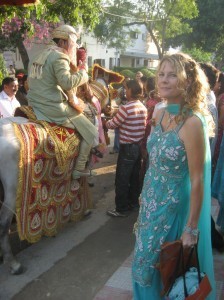
Adams at an Indian wedding, Chandigarh, India. Photo courtesy of Christina Adams.
I was born with a need to write. You can also call it epigenetics, where genes are ripe for change when impacted by their environment. I’m sort of a natural reading savant, and I grew up in a house loaded with books. I started writing as a child.
7) What are you working on right now? How did the project come to you, and why is it important?
In October 2005, after my book came out, I took my son to a children’s book fair, where I saw a man with a camel. So I went to find out why a camel was there if no kids were riding it. When the man said he sold soaps and lotions made from camel’s milk, for some unknown reason I asked, “What else do they do with it?” He told me it was given to premature babies in Middle Eastern hospitals and thought to be non-allergenic. I had a strong intuition that camel’s milk might help my son’s immune system, and maybe improve his functioning. I also wondered if it could be a suitable dairy substitute for people who can’t have cow milk.
I went home and researched camel’s milk on Pub Med, the medical journal data base, but I found nothing significant. A few months later, I discovered a report by an Israeli veterinarian that suggested some autistic kids who consumed camel milk showed improved functioning. I managed to import some frozen raw Bedouin camel milk. I gave some to my son, and I witnessed an incredible overnight improvement in his autism symptoms.
I never looked back.
My work in progress is about my journey from a newly single mom to camel milk advocate, and how I found true love along the way, against a backdrop of Amish, Bedouin, Middle Eastern, African and other camel cultures. After writing and lecturing about camel milk since 2012, I published my first medical journal article in 2013–an unusual credit for an MFA graduate who’s not an MD or PhD! So I actually ended up writing the Pub Med article I was looking for back in 2005. And I have a new project underway now with UC-Irvine on camel milk.
8) What is one of the most important lessons you have learned through the writing process?
I have learned to be honest in fact and bold in the story. If you have something to say, even if it’s been written a thousand times before, writing it with truth and skill means someone will read it.
9) How do you balance time to write with other facets of life that demand attention?
If you’re a parent, it’s all about the babysitting. If you’re not a parent, it’s about how much energy you have after work, and whether you want to spend your free time writing. I’ve been in both situations over the years. I did a lot of writing, media and speaking from 2001-2009. But in that period after separating from my son’s father in 2005, I encountered new challenges. Living on my own as the main caregiver for my son with no help or family nearby was a tremendous challenge. I did some freelance work for businesses and newspapers, but when the execs wanted to talk at 5 pm as they stepped off a plane and I had already picked up my son at 4, it was too hard.. Before my son started drinking camel milk, he required even more supervision. With all of these challenges at play, I realized I couldn’t re-enter the business world. Plus I got sucked into a powerful divorce vortex, and the time and focus for a new book receded every day.
I met my now-husband 2007, after an intense daily reading and writing journey in which I reflected on my future goals and happiness. It was lovely to leave the sterile emotional landscape of a past marriage and enter a marriage filled with compassion and devotion. Enjoying our courtship, blending my new family of three stepdaughters and my son, and travelling took time. I hated not publishing for around three years, but I was also researching camel milk, which only required a Skype account and a computer. Then I started writing pieces for Autism File Magazine. Now that my son has matured, is doing well and spends more time away from me, I’ve returned to steady writing.
Sometimes you have to put yours or others’ needs before the need to write, whether those needs are economic, health or emotional. But that doesn’t mean you should ever stop writing all together. It’s still healthy to fit in a little writing, so you feel empowered and don’t lose your “writer thought patterns” or confidence.
10) Who is your favorite author? Why? How were you first exposed to this writer?
Somerset Maugham is a favorite classic author of mine. He wrote the first major book I read as a child, Of Human Bondage. My mom, a coal miner’s daughter from a family who loved education but didn’t get much of it, had it at home. Later, I admired how Maugham’s other books delicately brought raw social situations to life, such as in Mrs. Craddock and Cakes and Ale.
11) Do you find that seasons inform your work?
Not really. I love them, but they only enter my work when I’m writing about them specifically. Nature is part of my general inspiration, since I grew up among woods and trails. And now I spend time on camel farms, so I enjoy and describe those varied landscapes. If I lived in a place less sunny, I’m sure seasons would be more influential!
12) Who have been some of your biggest influences?
My mom started reading Edgar Allan Poe to me as a baby. I read through our small county library as a kid. I’d read six to 10 books a week. Those myriad writers loaded me with riches. My teenage reading of John Steinbeck (Grapes of Wrath, East of Eden) and the poetry of John Donne, Robert Creeley and Frank O’Hara, to name a few, gave me a sense of wordplay, immediacy and structure. I admire women who push cultural boundaries with their traditions, like Sojourner Truth, Patty Smyth and Anne Sexton. Women are largely missing from history, but I’m moved by the work we do have, like the Chinese and Middle Eastern women who left some brilliant and moving poems. I like how John Krakauer blends first-person narrative with nonfiction.
I’m satisfied when the truths of one person emerge as universal, in fiction or nonfiction. Anyone who tells the truth is a hero to me.
Connect with Christina:
via Facebook – https://www.facebook.com/christinaadamsauthorautismadvocate
via Twitter – @camelmilkinfo
via Email - cadams@xiqllc.com
September 30, 2014
Seven Things You’ll Hear from a Four-Year-Old in the Game of Life
Lately, my four-year-old son has been asking to play that classic board game, “Life.” For a while, I pushed back. Too hard for a little boy. Too many pieces. Too many big words and ideas he would not understand.
But he kept pushing.
“Please?” he begged. “Can we just try it?”
Well. You’ve gotta admit: His can-do spirit is downright admirable. What sort of parent would I be if I quashed it?
Below, seven things you’ll hear from a four-year-old when he challenges you to a game of Life:
He informed me of this when I came back to the game for my turn, having left the room briefly for a glass of water.
“How do I have 2?” I said. “I should only have one.”
“You got married at the stop sign,” he said. “But then you ran into another stop sign, so I gave you another husband.”
“The second stop sign doesn’t mean I get married again,” I said. “It means I buy a house.”
2. “I want this house! I think it’s on a farm!”
He was looking at pictures of three houses with three different price tags, and he was smitten by the one with the picture of a cow and a milking bucket on it, owned, naturally, by Eula B. Milken Realty. The house cost $160,000.
I told him he’d have to give up paper money of various colors to do it.
He didn’t like that idea.
I explained to him that the ramshackle two-story cost less than the farm house, which meant he wouldn’t have to give up as much money.
“But I want to go home to the farm every day,” he said with disdain.
“Okay, then let’s buy it,” I said. “You’ll still have money left over.”
3. “I don’t want a house. It costs too much money.”
My young son was proud of his hard-earned cash as an athlete.
I told him it was probably a good idea to buy a house. As an athlete, he had plenty of money to do it.
He wasn’t swayed. So I tried to explain the house-buying process in the context of his earning coins for his pigg ybank that he could later use to buy toys.
“You know how you save up coins in your Colts helmet piggy bank for when you want to buy a toy?” I asked. “You have to spend your coins to get the toy. You lose some coins, but you get a really cool toy. To buy the farm house, you have to spend some of your money. You lose some money, but you get a really cool farm house.”
“Okay, okay,” he said with a sigh. “I’ll buy the farm house.”
4. “I don’t want a little girl. I want a boy.”
“In real life, you don’t get to choose whether you have a boy or a girl. You get what God gives you. The square you landed on says you have twins. And you got two girls.”
Another relenting sigh followed.
5. “What is a stock?”
“I’ll tell you later.”
6. “Mom, this game of Life isn’t really like real life.”
“I know.”
“I don’t get to spend any of my money in this game on toys. And that’s what I want to spend all of my money on, on toys. In this game, I don’t have any toys. But in my real house, I have lots of toys.”
Yeah, well.
We each had a pile of colorful cash before us. Counting money at the end of a Life game requires a bit of strategical mathematical thinking yet unlearned by a 4-year-old. Our totals would each be in the millions.
He can count to 50 without help.
“Sure,” I said. “You win.”
“Yes!” He pumped his hand in the air.
September 9, 2014
Writer Interview: Daniel Asa Rose on Leaving Behind True Stories and Larry’s Kidney Optioned for Film
When Daniel Asa Rose blew onto the scene at Western Connecticut State University the summer I began my MFA in writing there, I was simultaneously unsurprised and mystified. Fellow students had talked about him as this energetic, moment-by-moment free flyer, and that’s exactly who he was. But still, from the plaid Bermuda shorts to the iconic straw hat, he had a way about him that completely set him apart from other writers there. How lucky was I to be assigned as one of his mentees, a professional-writer-in-training whose work would be coached and prodded by him.
Daniel saw me through four years as a graduate student and the making of my first published book, Tough Love: A Wyoming Childhood. He showed me that conflict in writing isn’t necessarily all about exterior, outward problems; conflict can be just as scintillating when the narrator wrestles with herself. Daniel showed me how to grow from a shy, timid, tame writer into a writer with flare and boldness. He helped me learn how to own my words and own my stories.
Take it from someone who knows: Daniel Asa Rose is an author who rocks the world of creative nonfiction storytelling.
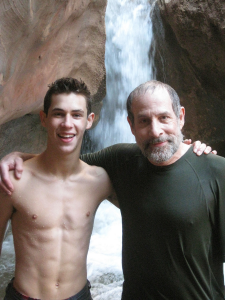
Daniel Asa Rose with his son, rafting down the Grand Canyon. Photo courtesy of Daniel Asa Rose.
1) Where (in what state) do you write?
My home bases are New York City and a little farming town in Massachusetts. But I also write from the road : China, New Mexico, wherever. I travel a few times a year, usually for a month at a time.
2) Do you find that place – your geographic surroundings – influence your writing?
They do only in retrospect. I love writing about past places I’ve found myself in, but rarely so with the current places.
During the last four years of writing my New Mexico memoir, for example, I wouldn’t let myself return to New Mexico. The same was true with China, as I was writing Larry’s Kidney. If I did go back, it would puncture the mythical places I had so painstakingly created in my mind. In a sense, I would see how “ordinary” the place was, as every place is. But I always need to nurture the sense that the particular place about which I’m writing is unique in the world, a mysterious fount of treasures.
Now that the New Mexico memoir is done, I feel it’s safe at last for me to go back there and enjoy the place for what it is. The New Mexico of my imagination is secure.
3) Describe your writing space. How did it come into being, and why is it significant?
My writing space exists primarily in my head. In New York, I write in the middle of Manhattan, with a big window view of the Empire State Building. In Massachusetts, my writing space overlooks a meadow and pond. But the mental work, regardless of where I am physically, is internal. My presence is focused inward.
4) When do you do your writing?
I write any time and all the time. Typically, the first few hours of my day are useless except for the making of coffee and phone calls. I just have to get through them. Slowly, it picks up until by mid-afternoon, I’m cooking.
5) Where do you find inspiration for what you write?
I find inspiration everywhere. Yesterday, I was at a hardware store, and the cashier spoke over the intercom: “Wendy, two is not enough. Wendy, two is definitely not enough!” It was a perfect haiku, readymade.
6) Why do you write?
I write to keep from suffocating. I would just feel everything is pointless unless I could leave an account of myself and my progress through life. If I didn’t write, I would feel claustrophobic and panicky.
7) What are you working on right now? How did the project come to you, and why is it important?
I am finishing a memoir set in New Mexico. The project has been my life for five years. I cannot get to the next thing until I finish the current thing.
8) Your book, Larry’s Kidney: Being the True Story of How I Found Myself in China with my Black Sheep Cousin and His Mail-Order Bride, Skirting the Law to Get Him a Transplant — and Save His Life, was recently optioned for film. Can you briefly talk about the success of the book, and where the film project currently stands? 
Working on Larry’s Kidney was the most fun of my life. It just wrote itself in a fury of 6-to-8 months. And for a while, it seemed the film would go the same way. But it’s hit the usual road blocks: financing, scheduling problems, etc. Zack Galifianakis and Will Ferrell are still in to play my cousin and me, and Richard Linklater is still the director. But it may be a while before it all comes to pass. Keep the faith!
9) What is one of the most important lessons you have learned through the writing process?
I’ve learned that there are a million ways to do it right. I’ve learned not to be paralyzed waiting for the perfect words, but to set down the words that present themselves and move on.
10) How do you balance time to write with other facets of life that demand attention?
I balance time by feeling constant pressure and stress. Breathing helps, when I remember to do it consciously.
11) Who is your favorite author? Why? How were you first exposed to this writer?
I’ve had so many favorite authors. A huge influence on me was Faulkner. I studied Faulkner in an ordinary college course my sophomore year. I remember walking to my dorm after class in the twilight, and everything seemed touched with mystery and purpose.
12) Who have been some of your biggest influences?
Goodness, there are so many ! Faulkner, Orwell, John Lennon , my mother , the Russians …..
To learn more about Daniel Asa Rose and his work, visit www.danielasarose.com.
August 12, 2014
Writer Interview: LaDene Morton
I came to know author LaDene Morton through Women Writing the West, an organization that promotes writers who showcase women against the backdrop of the American West. LaDene put forth a tremendous effort in organizing the 2013 Women Writing the West conference in Kansas City, where I now live. Over delicious lunch dates at Panera – our signature meeting spot – LaDene and I have come to know and respect each other as writers, teachers, speakers, and human beings trying to figure out how to communicate stories to the world.
“Artist / Writer Interviews” spotlight working artists and writers – the spaces in which they work, where they find their inspiration, what makes them unique. I feature one artist or writer each month. If you are a working artist or writer who would like to be considered for this series, or if you want to recommend an artist or writer to interview for this series, please contact me.
1) Where (in what state) do you write?
I write in Missouri, specifically Kansas City.
2) Do you find that place – your geographic surroundings – influence your writing?
Photo courtesy of LaDene Morton.
Absolutely! When I envisioned the story of my novel, What Lies West (a historical fiction set in the 1850s American West), I began the protagonist’s journey right here, where so many real pioneers started their own westward journeys. The neighborhoods in which I have lived and worked throughout my time in Kansas City (I have lived here since the late 1970s) became the subjects of my two non-fiction local history books, as well as the one currently in the works.
I find my geographical surroundings also influence my ideas for future projects. Regardless of whether these ideas ever materialize into story, I can hardly drive around town, read the local newspaper or recall childhood memories in the area that don’t evoke some sort of narrative or character idea.
3) Describe your writing space. How did it come into being, and why is it significant?
My “sidekick,” Roger, and I live in what was originally an old two-story duplex. He owned the duplex when we met 30 years ago. When I finally moved in, I secretly coveted the upstairs apartment, which was just a storage space as far as Roger was concerned. Slowly, I began to reclaim it, and now, the whole front half of the apartment is my office. The two apartment rooms are open to each other, with the old dining room area serving as my library, and the living room as my work space. It is wonderful and bright, with French doors that open to a large balcony. It is a little like being in a tree house – with fewer bugs.
The main reason I’d say the space is significant is that it is almost exactly how I envisioned my perfect writing room when I was young: lots of windows, lots of books, filled with my favorite pastimes. Long before I knew I wanted to write, I knew I wanted to work in a room like this. I feel completely comfortable, creative and productive there.
LaDene Morton’s writing space. Photo courtesy of Ladene Morton.
4) When do you do your writing?
I write when I can. I am a community development planner who works closely with non-profits – this is my work that pays the bills. I wish I possessed more discipline around my writing time, but the reality of my job doesn’t always make disciplined writing time practical. Generally, whenever I have a paying gig for an organization, I simply put my own writing projects aside. Then, when it’s time for my project, I treat that like I would a client’s project. It’s a 9-to-5 effort, organized on the calendar for research, drafting, writing, editing, production, the whole works. I don’t know any other way to work, regardless of what the project is. But it is during those periods of actual writing – usually in the mornings, when the world is still filled with possibilities and I have the most mental energy – that I generate the most and best creative work.
5) Where do you find inspiration for what you write?
Gee, where don’t I find it? Seriously, one of my personal challenges is to figure out how to decide which (if any) of the wild ideas that come into my head are worth pursuing. I find inspiration in everything, from the pages of history to the latest news story.
6) Why do you write?
I write because I love a good story, and when I think I have one, either one I’ve invented (fiction) or one I’ve found (nonfiction), I can’t wait to share it. And if I think I’m the only one who can share it, or the best one to share it, then I really get excited to write.
7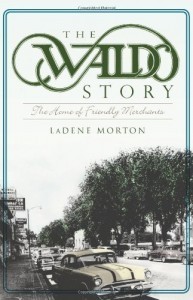 ) What are you working on right now? How did the project come to you, and why is it important?
) What are you working on right now? How did the project come to you, and why is it important?
For the last five years, I have been focusing on local history. I have completed two books on the history and evolution of Brookside and Waldo, two communities in the heart of Kansas City, and my current project focuses on the history of Kansas City’s Country Club District. It is likely to be my final local history, at least in this particular area of Kansas City community history. The project came to me largely as a result of research for the other two projects. I found the historical importance of this area – both locally and nationally – is either forgotten or misunderstood. Anytime we forget why something is important, we run the risk of losing it completely.
8) What is one of the most important lessons you have learned through the writing process?
I have learned how to subordinate your ego for the greater good of the piece. For example, I know the value of keeping my work on a tight leash and resisting the indulgences of personal gratification that don’t do the work one damn bit of good. I also have learned to ignore the bruising the ego from enduring criticism. You do need a thick skin to be a writer. But more than that, it’s about putting the focus more on the work than on yourself.
9) How do you balance time to write with other facets of life that demand attention?
I don’t balance them at all. I am the world’s worst when it comes to balance. Perhaps if I had taken up writing earlier in life before all of my habits (particularly the bad ones) were in place, I would be better at it. As it is, I write when I am fired up and ready to go, and if other things have to take a back seat, so be it. Unfortunately, sometimes it’s the other way around. When chores, errands and obligations demand my attention, the writing has to wait its turn.
10) Who is your favorite author? Why? How were you first exposed to this writer?
There are too many variables to pick just one. Favorite for style? For a heart-thumping plot? For superb characters or beckoning settings? I just can’t do it. But I will say that one author who stands out on each of those lists is Emily Bronte. Jane Eyre was my first exposure to literature. I read a lot of books as a kid, but I knew I had entered a whole new realm when I read Bronte. Then Dickens, and Twain, and later Vonnegut and Marquez. I am a sucker for a great novelist, that’s for sure, no matter their style.
11) Do you find that seasons inform your work?
I have never considered that before. I don’t know that seasons inform my work. I do know that the older I get, the more energy and hope I have once spring comes around. Winter sometimes leaves me feeling too bleak to write. It is definitely my least productive time of the year.
12) Who have been some of your biggest influences?
Mostly names that don’t mean anything to anyone but me, because of personal stories I’m not yet ready to share. But the people in these stories have influenced me as a person, and more than influencing me as a writer, each of their influence has had a part, in some way, to leading me to writing.
*Learn more about LaDene’s work by visiting her Amazon page, or her corner at The History Press.
August 8, 2014
Follow the Thread
When I started writing chapters of my book, Tough Love: A Wyoming Childhood, I did not have a concrete vision of what the book would be about. All I knew in the early phase was that I had a lot of childhood memories inside of me – good and bad and fun loving and challenging – and a lot of people who had done their fair share in shaping those memories. There was a lot to explore. And those memories and stories were pounding inside me, pleading to be let out, pleading to be set free.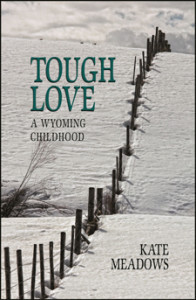
Something surprising happened as I continued to write and revise, write and revise. The book chapters largely started to become an exploration of my complex emotions toward and relationship to my grandparents.
Now that, I never intended.
The writing was hard. It was agonizing at times. Some sentences I pounded out through tears. To see my thoughts, black and real, staring back at me from the computer screen was at once alarming and freeing.
In this act of writing I was communicating some hard truths. I was knitting together a story I never actually set out to tell. But it was, at the time, the story that needed telling. Among the thorns and roses of memory, a story of complex love emerged.
So often, writing is an act of faith. You recognize a single loose end of a thread and you start to pull it, unsure of how it’s going to unravel. You don’t know where you’re going. You know you have to keep going.
That’s faith. It’s having the courage to take the next step, even though the rest of the path is still dark. Sometimes, you only have enough light to see directly in front of you.
Keep going.
Through the tough writing and the unraveling of some momentous events that, years after taking place still needed mining, I finally set a complete story free. Tough Love: A Wyoming Childhood, recounts my years as an only child growing up in the harsh and untamed country of western Wyoming, being molded by and learning to love the very people – those grisly, hard-bitten characters – who you’d think would have been the last to teach me about life’s greatest gift.
Prompt: “Number a page from one to ten and write down every topic you could write about right now. Go with whatever ideas bubble up.” (from The Writer’s Workout: 366 Tips, Tasks & Techniques from your Writing Career Coach, by Christina Katz) (Writer’s Digest Books 2011)
Happy Friday!
July 18, 2014
The Friday Spark: Lawn Mowers
Periodically on this blog, you will encounter a little gem I call “The Friday Spark.” I hope to make this a more regular feature in time. “The Friday Spark” is my way of saying, “Happy Friday!” It is a bundle of words, an idea, gifted to you for creativity and, perhaps sometimes, nostalgia. It may come in the form of a writing prompt. It may be a resonating quote with a bit of background. It may be a vignette of something that struck me, something I wanted to share with my readers to pass on a creative spark. Whatever the case, I hope you find “The Friday Spark” a fun glimmer to your daily (and weekly) grind. Here’s to Friday. Cheers!
SPARK: What’s the first memory that comes to mind when you hear the word “lawn mower?”

Photo courtesy of www.creativecommons.com and Don O’Brien.
I remember petty love notes to teenage boys. Really. Mom and Dad paid neighborhood kids to mow our big lawn. Boy-crazy little me, at a ripe age of, oh, 9 or 10, would fashion a “love note” on a notepad decorated with the “Best Western” logo. The note looked something like this:
Do you love me? Circle it.
Yes
No
I really did write, “Circle it.” One response, from the teenager who thought I was an innocent blast, circled “Yes.” Another teenager, always stoic and stone-faced serious, circled “No.”
Dad taught me how to mow the lawn when I was 13 or 14. I kissed those meaningless little love notes goodbye, slipped on a tank top that showed off my muscle (all those nights shooting hoops in the driveway paid off), tied a bandanna around my head, clipped a turquoise Walkman to my belt, and rocked out to Smashing Pumpkins. An hour-and-a-half later, I was $20 richer.
A friend of mine recalls the noise of the lawn mower on summer evenings. She shared a room with her sister, and at
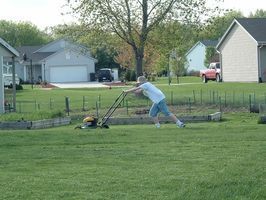
Photo courtesy of www.creativecommons.com.
bedtime they lay in their beds, clad in pajamas, fiery and full of childhood energy. When they heard the rumble of the lawn mower come to life, they knew they had a solid half hour more to play in their room, unnoticed. The noise meant their parents were still outside, tending to the yard and blissfully assuming their kids were tucked in for the night. The girls played and played. But as soon as the lawn mower shut off, they bounded back to bed, pulled up the covers and closed their eyes. “Sleeping” sweetly, Mom and Dad thought, as they checked on the girls.
How about you? First memory that comes to mind when you hear the word “lawn mower.” Happy writing!
July 7, 2014
Writer Interview: Sonja Mongar
Creative nonfiction and, more recently, fiction writer Sonja Mongar, is responsible for a good chunk of my growth and path as a writer. A mentor in Western Connecticut State University’s Creative and Professional Writing MFA program, she once challenged me to keep a semester-long journal called “Why I Write.” That project culminated in a final essay on the subject, a sort of manifesto that has become my rudder, guiding my pursuit as a writer ever since. A modified version of that essay, “Artmaking,” appeared in Writer’s Digest in 2012. Sonja’s insight and wisdom into a life of art making is my Tuesday treat to you.
“Artist / Writer Interviews” spotlight working artists and writers – the spaces in which they work, where they find their inspiration, what makes them unique. I feature one artist or writer each month. If you are a working artist or writer who would like to be considered for this series, or if you want to recommend an artist or writer to interview for this series, please contact me.
1) Where (in what state) do you write?
Currently, I write in Spokane, Wash. I just moved to Washington State from Puerto Rico, where I lived for the last 13 years and worked as a professor of English teaching creative writing. I left a tenured teaching position to go back to my writing full time.
2) Do you find that place – your geographic surroundings – influences your writing?v
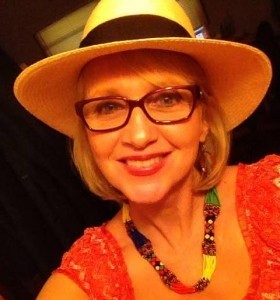
Sonja Mongar. Photo courtesy of Sonja Mongar.
Being a writer means always being aware and observant, so wherever I am, place becomes a part of what I write and shapes me. I have lived in so many different geographies/places: the Great Plains, the Bitterroot and Cascade mountains, the Columbia River Basin, along an Oregon river, near a North Atlantic seashore, in an urban Italian neighborhood in Queens, on a 1950s Midwest college campus, beside the railroad tracks in wheat country, in the subtropical Atlantic with its sugary beaches and on a Caribbean island. Each place has its unique landscape, culture, dialect and mood which have made their mark on both my identity and my imagination.
3) Describe your writing space. How did it come into being, and why is it significant?
Because my lifestyle has been so mobile, my writing space for the past 20 years has had to be wherever I could set my laptop. Right now, I’m settled in my mother’s sewing room with an iMac desktop while I make my transition into life in my new hometown. But I find I cannot concentrate when I am “home,” partly because computers have their own virtual geography. My iMac’s geography is business, teaching, researching, web designing, editing, socializing and even shopping! I recently transferred my current work-in-progress to a new laptop, a laptop on which I do nothing but write. Some of my best writing happens when I can take my laptop and find a cozy corner of a quiet coffee house or a breakfast cafe. Something about the clash of dishes, smell of coffee and the sizzle of the grill transports me.
4) When do you do your writing?
I’m more productive when the sun goes down. Again it’s probably about shutting out distractions. I dislike turning off my story once I start, thus evening offers a huge block of uninterrupted time. If I am able to write all night, generally I don’t stop. Then I sleep. Then I write. It’s like a marathon.
But all-night writing is not always practical. So recently I have been experimenting with Julia Cameron’s (The Artist’s Way) three-pages-a-day method. At three pages a day, 30 days of writing 90 pages of work. The idea is captivating, but the three pages a day is so far not working well for me. If I fail to write the three pages, I beat myself up because I’m not disciplined enough. It is, however, forcing me into a routine and keeping my story and characters in the forefront on a daily basis. Whether I write all night and day for a week or squeeze in three pages every few days, I am realizing the only thing I have to be diligent with is to believe in myself and my writing. The rest will follow.
5) Where do you find inspiration for what you write?
I write about what I know, but I don’t let what I know limit my interests or my imagination.
I have always found real people’s stories so much more interesting than stories I invent. One look around me at any given time reveals the richest stories and most engaging characters are sitting next to me on the bus or talking to me in my mother’s kitchen. I love to live vicariously through these people and their stories.
I am planning trip by train from Spokane to Chicago to see my grandson graduate from Navy school. On the way I pass through Red Wing, Minn., where my current protagonist grew up. I am anxious to capture some significant and authentic details of place and characters in Red Wing.
6) Why do you write?
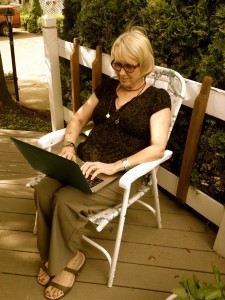
Photo courtesy of Sonja Mongar.
“The role of the writer is not to say what we can all say, but what we are unable to say.” -Anais Nin
I write to express the magic in everyday stories and people. I want to be a voice for the voiceless. I want the reader to hear the music, marvel at the art, be inspired by the people and feel a universal sense of empathy and connection; community.
I write because I want to make sense of and give meaning to those fragments that comprise my life. I write to find peace and to perhaps connect to others who share a commonalty with my narrative.
I write to imagine and invent even more. It’s fun and somehow therapeutic. Aristotle said, “Art is therapy.”
It took a long time for me to come around as a writer. I raised a two kids, attended marriage counseling, survived the day-to-day. When I went back to school, I majored in photography. But I saw all these really sharp, young student photographers in my classes, and I felt way out of their league. So I switched to journalism. In my magazine feature writing course, I was the first one to get published. It wasn’t long before I was writing for local publications and I found a niche with features, especially arts, music and profiles.
But writing features for local publications didn’t pay well. So I took a job at a drug rehab treatment center. I barely lasted six months. I kept a diary of the terrifying and heartbreaking real life stories I heard and my daily struggles over the hypocrisy and corruption of the institution. I wanted to write the stories but I felt I needed more than journalism skills to pull it off. I applied to a Creative Writing Masters program and used my diary as my portfolio. Little did I know that majoring in creative nonfiction meant I had to write – not my former clients’ stories – but my own. And that’s where the floodgates opened and my words, my voice came pouring out.
7) What are you working on right now? How did the project come to you, and why is it important?
Creative nonfiction, memoir and life narrative have been the subjects of my research and what I have considered my life’s work for decades. But I never satisfactorily finished the memoir of my brief stint working at the rehab center. For the last 20 years, the project would not leave me alone. So I put one of my philosophies to the test: to allow the story and the characters/subjects to choose the structure of their narratives and their points of view. Even still, the story felt like Marley’s chains in Dickens’ Christmas Carol hanging around my neck; rather than freeing and a way to reach peace, the story felt like something I would have to drag around for the rest of my life.
So, I decided to try writing it as fiction. Was it my pride perhaps that was getting in the way of telling the story as nonfiction? Or that journalistic commitment to truth? Hemingway writes in his memoir, A Moveable Feast: “… All you have to do is write one true sentence. Write the truest sentence you know.”
The truth was in the fiction. It opened the story up in ways I never fathomed. Every page is a new discovery.
8) What is one of the most important lessons you have learned through the writing process?
The most import aspect of the writing process is to understand the art is in the making. Not in the book sitting in Barnes & Noble or Amazon.com. Not in the check from the publisher. Not in the reading out loud to groups of people. It’s in the creative process.
9) How do you balance time to write with other facets of life that demand attention?
I don’t think there ever exists a balance between writing and the rest of one’s life. When I write, everything else disappears. Dishes and laundry pile up. Meals don’t get cooked. Sometimes I don’t even get dressed; I write in my pajamas.
My kids are grown. They launched well and don’t need me hovering. I have four grandkids between ages 3 and 21 living in four different states, and I’ve been as involved in their lives as I can. I’m not married anymore. I’m semi-retired from my full time teaching career. When I finally do get my own place, it will be a small apartment with low maintenance. I don’t own a lot of things. I’ve cleared out a lot of space to write. White space.
10) Who is your favorite author? Why? How were you first exposed to this writer?
Mary Clearman Blew. She’s a Montanan and a memoirist like me. I learned about place as character from her work. Every detail she rendered resonated in my own story. I clearly saw the empty frontier landscape of my ancestors and the one I knew as a child as one that lived in my own soul. Now that’s writing.
11) Do you find that seasons inform your work?
I’ve been season deprived for over half of my adult life from living in the sub-tropics and tropics. This year was my first spring in the north since 1982. The flood of senses: colors, scents, sounds, temperatures. At the same time my synapses fired with memories connected to these sensations. It was like watching a very fast slide show. The emotions associated with the memories were overwhelming. But it reminded me how the senses play such a huge role in writing.
12) Who have been some of your biggest influences?
In the creative nonfiction realm, I am blown away by Joan Didion, Norma Cantu, Mary Carr, Patricia Hampl, Gloria Anzaldua, Joann Beard, Virginia Woolf, Zora Neale Hurston, Mary Clearman Blew, and Anais Nin. But literary movements have also had a huge influence on my writing and taught me so much about story. Additionally, I trained in improv storytelling theater. There was something about seeing peoples’ stories acted out on stage that gave another whole dynamic to my concept of story. So I am inspired by screenplay writers/filmmakers like David Lynch, Coen Brothers, Quentin Tarrantino, and Lars Von Trier. Music, art, photography all have narratives too. I think it’s really important to sample a range of genres and modes as a writer and keep myself open to all the possibilities of story.
Learn more about Sonja Mongar’s work HERE:
http://www.saguache.org/towns/bonanza/index.html#Etta (link to part of an auto ethnography about her great-great grandmother)
June 3, 2014
Why Do You Write?
The magazine Poets & Writers launched a totally beautiful and poignant column several years ago called “Why We Write.” Author and book marketing coach Jonathan Gunson posed the question in a blog post and asked readers to answer the question. http://bestsellerlabs.com/why-do-you-write/ More than 350 readers commented on his blog post alone. (More responded to his question on Twitter and Facebook.)
I was one of the 300-plus who commented on the blog post. My answer? I write because I can’t not write. I write to connect people through story and expression. I write because, at its base, writing is about communication and about understanding ourselves and others and the relationships we weave.
It’s a deep question. So many of us struggle to get at the answer, the real answer, to why we write. Here’s how several others responded to Gunson’s “Why do you write” question:
“It’s an affliction. Like a twitch I’m trying to control.”
“Because there is a story on my mind that I have to share with the world.”
“Because what percolates inside deserves a voice.”
“It’s the one thing that has consistently called me, my entire life. It’s also how I make meaning in my world.”
When I was in graduate school, one of my professors assigned me to keep a semester-long private blog, on which I posted thoughts as to why I write. She assigned reading material, essays called “Why I Write” by Joan Didion and others. At the end of the semester, she asked me to compose my own “Why I Write” essay.
It was one of the hardest and most rewarding assignments of my graduate school career. I found myself exploring the parallels of writing and motherhood, how both pursuits are fierce and demand your everything, how both are beautiful and messy and raw. How the learning curve of each never ceases. How the rewards, if your pursuit is dogged and all-encompassing, are out of this world.
How about you? Why do you write? Please share in the comments below.

